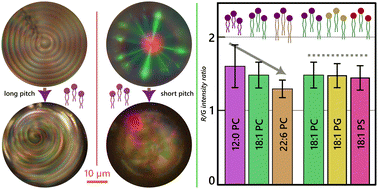Heads or tails: investigating the effects of amphiphile features on the distortion of chiral nematic liquid crystal droplets†
Abstract
Liquid crystal-based sensing has fast become a growing field, harnessing the sensitivity of liquid crystals to their surroundings to provide information about the analytes present, including surface-active amphiphiles such as biological lipids. Amphiphiles can impart ordering to a liquid crystal and, in the case of chiral nematic liquid crystals (CLCs), distort the helical texture. The cause and degree to which this distortion occurs is not fully clear. In this work, the effects of different amphiphiles on the final colour textures as well as the pitch of chiral nematic liquid crystals are investigated. We find that the tails of amphiphiles and their orientation play a more important role in determining the final distortions of the liquid crystal by the direct interactions they have with the host, whereas the headgroups do not play a significant role in affecting these distortions. Our findings may find implications in designing CLC-based biosensors, where the tails will likely have more impact on the CLC response, while the headgroups will remain available for further functionalization without having significant effects on the signal readout.

- This article is part of the themed collection: #MyFirstJMCC


 Please wait while we load your content...
Please wait while we load your content...